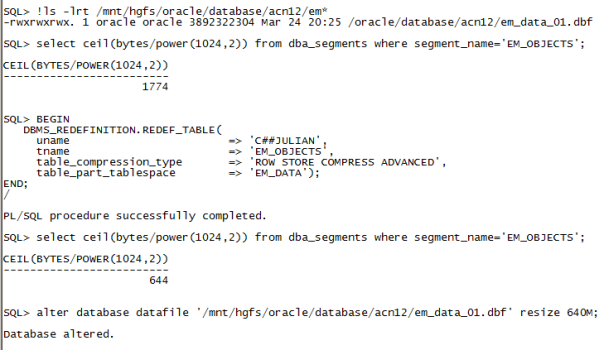Online reorganization enhancements in Oracle 12c
The Online Reorganization and Redefinition feature in Oracle Database offers DBAs significant flexibility not just to modify the physical attributes of a table but also to defragment and compress the table while allowing online access to the database.
A 5TB database can have 1TB of white space, in fact it can even have 4TB for all I have seen! Reclaiming the wasted space is important from both storage and performance perspective.
Before discussing the new 12c features related to online database reorganization, I will show you how easy it is to reorganize a table in 12c while at the same time all operations on the table are allowed. I have a tablespace called EM_DATA with just one datafile em_data_01.dbf and a table called EM_OBJECTS having more than 11 million rows. The file is almost 4GB in size. There are no another segments within the EM_DATA tablespace.
As you can see the segment EM_OBJECTS was 1774MB in size before the reorganization and after compressing it online we managed to shrink it to 644MB. The data in the table was not artificially ordered in any way whatsoever. Moreover, after the reorganization, I was able to resize the file down to 640MB and thus release more than 3GB of storage space on filesystem level!
Clearly, in 12c the complete procedure is very simple, there is no need to create explicitly the interim table but if an errors occurs during the execution, then the interim table is dropped, and the REDEF_TABLE procedure must be re-executed.
Now, here are all new features related to online redefinition in Oracle 12c:
1. The REDEF_TABLE procedure enables you to perform online redefinition on the table’s storage properties in a single step when you want to change the following properties:
– Tablespace changes, including a tablespace change for a table, partition, index, or LOB columns
– Compression type changes (as shown in the example above), including a compression type change for a table, partition, index key, or LOB columns
– For LOB columns, a change to SECUREFILE or BASICFILE storage
– Compression type changes (as shown in the example above), including a compression type change for a table, partition, index key, or LOB columns
– For LOB columns, a change to SECUREFILE or BASICFILE storage
Check out these examples.
2. In 11g, it was only possible to add or drop columns when redefining tables online. In 12c, we can now set an unused column online. Check Doc ID 1120704.1 for details.
3. New in Oracle Database 12c: drop index online, alter index visible/invisible, alter index unusable online, and drop constraint online. I would suggest the master note “An overview of online redefinition of tables” Doc ID 1357825.1 for detailed examples and known bugs.
4. Since 10gR2, it has been possible to reorganize a single partition with online reorganization. With 12c, the redefinition of multiple partitions in a single redefinition session gives us the possibility to reduce the completion time to redefine multiple partitions.
5. Redefinition of tables that have Virtual Private Database (VPD) policies defined on them helps us eliminate downtime for redefining these tables. On top of that, there is a new function called EXPAND_SQL_TEXT which has been added to the DBMS_UTILITY packages. It makes seeing what SQL is actually executed pretty easy.
6. The performance of SYNC_INTERIM_TABLE with Materialized View Log processing has been significantly improved in 12c. I really hope not to see any more ORA-32416.
7. There is also improved resilience of FINISH_REDEF_TABLE with better lock management: you can avoid user cancellations or indefinite waits by using the new dml_lock_timeout parameter when running DBMS_REDEFINITION.FINISH_REDEF_TABLE procedure. Amit Bansal gives more details here.
Finally, here is all about DBMS_REDEFINITION in 12c from Dan Morgan’s library.
Online database reorganization is something of paramount importance, especially nowadays, when downtime is hard to get and data grows rather exponentially. Removing the unnecessary data is something few people in the companies care about although often more than 50% of database data is nothing else but junk data. Buying and adding more storage seems to be the easier option although reorganized and defragmented databases have better performance and require less memory and CPU



No comments:
Post a Comment